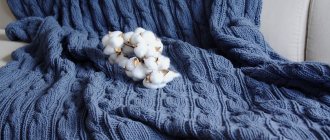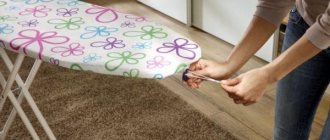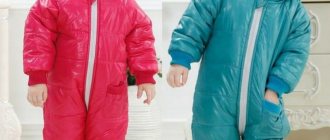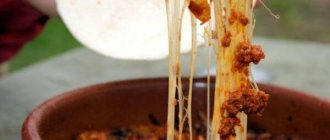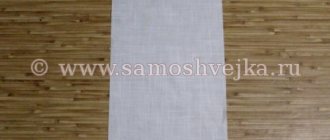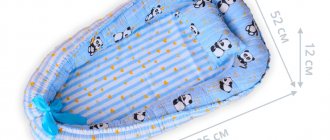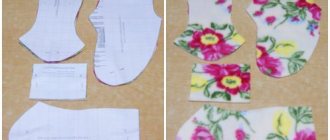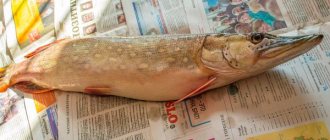What kind of bedding should be for a child?
When organizing a child's bed, the main task of parents is to ensure healthy sleep for the child and a comfortable atmosphere conducive to rest. The correct selection of bedding plays an important role. Lingerie should not only be of high quality, suitable in size, but also evoke a pleasant feeling in the baby.
When choosing fabrics, the baby's mother will be able to choose good quality material, desired colors and patterns.
Note! It is recommended to avoid too bright colors when sewing baby bedding for a newborn crib with your own hands. Contrasting shades can cause aggression and anxiety. It is better to give preference to neutral, calm shades.
Sizes and measurements
With measurements of linen everything is simple, as for adults; for children there is a classification of linen into single, single and double. It is sewn in two standards: European and Russian. Children's bedding should be sewn based on their height and their own preferences. In general, the standard defines the following sizes for children:
- Duvet cover - 110 - 120 centimeters by 140-150 centimeters;
- Sheet - 100-120 centimeters by 138-160 centimeters;
- Pillowcases - 40 by 60 centimeters.
READ ALSO: Crochet T-shirt for girls: 22 models with diagrams and descriptions
Important! A children's set differs from an adult's not only in size, but also sometimes in its contents. One of the features is the presence of elastic bands that secure the sheet to the mattress. This prevents the sheets from becoming wrinkled in the morning and ensures better quality sleep for your baby, who often tosses and turns at night.
Sewing children's bed linen
The sewing process is not complicated. It does not require special skills. You should start by measuring the sleeping area. This is necessary for correct fabric calculation. Next, you will need to prepare the following set of sewing tools and accessories:
- Main fabric and thicker material for sides;
- Well-sharpened tailor's scissors;
- Tape measure;
- Pins or bobby pins;
- Chalk or bar of soap;
- Threads;
- Long ruler;
- Iron;
- Sewing machine.
Selection of fabric and selection of bed linen design
When choosing fabric for children's bedding, the first thing you need to pay attention to is its composition. It should be completely natural, breathable. Preference should be given to hypoallergenic and environmentally friendly materials that are easy to care for.
This option will be a “lifesaver” if the bed has a non-standard size and it is not possible to buy bedding that fits the size.
The best option is cotton. Depending on the density and method of weaving the threads, you can choose a fabric for both summer and winter use.
This is also a good motivation for using your skills in handicrafts or for mastering something new and useful.
Types of natural and hypoallergenic fabrics:
- Chintz. Soft, tactilely pleasant material. Due to its thinness, it has good breathability and moisture-absorbing properties. Does not require special care measures. The disadvantages include low wear resistance.
- Calico. One of the most popular options. It is highly durable and does not interfere with air circulation. Disadvantage: rougher to the touch.
- Satin. It has many advantages: it does not wrinkle, does not accumulate static electricity, and has good thermal conductivity. A preferred option for summer, as the material creates a cooling effect. Satin is wear-resistant and easy to care for: it does not wrinkle, maintaining the same appearance from wash to wash.
- Linen. It is characterized by moisture absorption properties, breathability, and thermal conductivity. It is worth considering that linen is quite hard. Disadvantages include high cost and the need for more delicate care.
- Bamboo. The material has high strength and antimicrobial properties. Absorbs moisture well and neutralizes foreign odors. Cons: high price.
Important advice! When selecting fabric for sewing children's bedding, it is advisable to give preference to satin or bamboo. These materials are durable and easy to maintain. They will promote comfortable sleep by absorbing moisture and allowing free air circulation.
When choosing a design, it is important to consider the age and gender of the child. Girls most often prefer delicate pastel shades: peach, yellow, pink or lilac. Young guys, on the contrary, choose contrasting, rich colors: deep blue, purple or green. 3D prints are popular, which can depict your favorite characters from cartoons and fairy tales. Such underwear develops the child’s imagination and helps to fantasize.
It is necessary to consider only high-quality, natural fabric.
Fabric consumption when sewing
In order for the pattern of children's bedding to meet the required dimensions, you will need to accurately calculate the required amount of fabric. The easiest way to do this is by measuring the existing kit. If there is none, you need to measure each element: pillows, mattress and blanket.
The best option would be 100% cotton fabric. Cotton bed linen is suitable for both summer and winter.
Taking into account the space for hems and seams, the following should be additionally added to the measurements obtained:
- For a duvet cover - 5 cm on each side;
- For sheets - 10 cm;
- For pillowcases – 4 cm;
Important! We must not forget about the shrinkage percentage of any material when calculating how much fabric is needed for a set of children's bedding for a crib. This information must be indicated on the packaging. Typically, the shrinkage rate varies from 1.5 to 3%. Washing and ironing should be done before cutting.
How to sew a duvet cover without a pattern?
To sew a duvet cover without a pattern, you just need to know the length and width of your duvet. To avoid disappointment, measure it carefully. To do this, place the blanket on the floor, smooth out the folds, if any, and, without stretching the fabric, measure the length and width of the blanket. The resulting dimensions will be the basis for the duvet cover pattern. To these measurements you need to add seam allowances, and this is approximately 3 cm on each side, or just add 6 cm.
Don't forget that the thickness of the blanket also needs to be taken into account when sewing a duvet cover. So for a thin blanket up to 1 cm, you don’t need to add anything. For a blanket of medium thickness, 2-3 cm. And for a thick blanket, 4-5 cm. To avoid mistakes, apply a ruler to the blanket lying on the floor and visually determine this size.
The width of the fabric for a duvet cover can be different, and when calculating its consumption, you need to rely on the width of the fabric that you are going to buy.
If you use narrow cotton fabric 90-95 cm wide for sewing, then your duvet cover will consist of strips of this fabric the length of your blanket. So, to sew a duvet cover you may need 2-3 stripes.
How to sew a duvet cover from fabric, 95 cm wide
Let's consider the fabric consumption for a children's chintz duvet cover of a standard size with a width of 90 - 95 cm:
If you want to sew a children's duvet cover from a fabric 95 cm wide, then this width will not be enough for one side of the duvet cover, if the blanket is, for example, 110 cm wide and 140 cm long. This means that you will have to buy three lengths, plus seam allowances. In our example, this is 140 multiplied by 3, and add approximately 20 cm of allowance. In total, the fabric consumption will be 4 meters 40 cm.
From leftover fabric you can sew pillowcases for small pillows.
For a duvet cover for a one-and-a-half blanket, with a width of 140 cm, you will need a piece of fabric 95 cm wide and a length equal to the length of the blanket multiplied by 4.
Is 3 lengths enough to sew a one-and-a-half-length blanket?
- A simple calculation shows that if the width of the fabric is 95 cm, then you need to multiply 95 by 3, and we get 285 cm. For seams, if the width of the blanket is 140 cm, only 5 cm will remain. This may be enough if the blanket is thin, or maybe may not be enough if the blanket is thick.
- For a double duvet cover with a width of 172 cm, you will need to buy 4 lengths if you are sewing from fabric 95 cm wide.
- The wider the fabric, the less you will need to buy. If you don’t know how to sew a 1.5-sleeper, 2-sleeper, or children’s duvet cover from fabric 220 cm wide, also rely on the length of your blanket.
Don't forget to take into account seam allowances and allowance for the thickness of the blanket.
Let's consider the fabric consumption for a 220 cm wide chintz duvet cover:
If the length of your blanket is no more than 215 cm, then when sewing a duvet cover from fabric 220 cm wide, it is enough to measure the width of the blanket and buy fabric based on 2 times the width of the blanket plus seam allowances.
Such wide fabrics are created specifically to sew a duvet cover with your own hands, as well as sheets and other bedding. The pattern on such fabrics also takes into account that this is a fabric for bed linen, and it is not located vertically, but horizontally relative to the edge of the fabric.
Wide fabrics to sew a duvet cover with your own hands
Step-by-step sewing instructions
After preparing the necessary tools and materials, you can begin the process of cutting and sewing each element. Upon completion of all stages, you will need to iron and steam the finished products.
Pillowcases
For newborns, it is recommended to choose a pillowcase model with a valve. Standard size – 50 x 70 cm.
- Measure the required piece from the original fabric, leaving allowances for seams and 30 cm for the flap, as indicated in the diagram. Fold the resulting cut right side inward.
- Edges that are not finished with a factory seam should be sewn using a sewing machine.
- Fold the 30 cm calculated for the valve upward. Thanks to this, the pillow will be securely fixed inside the pillowcase.
- Fold the sides flat and stitch. First, make seams on the front side, then on the back. This will ensure high strength of the product.
When the pillowcase is ready, it will need to be ironed with a steam iron.
Sheets
A standard sheet will be sewn simply and quickly:
- Measure and cut a piece of the desired size, leaving seam allowances.
- Fold each raw edge inward once (for a machine without an overlocker - 2 times), stitch. If the factory finishing of the edges is of poor quality, it is recommended to stitch them.
The process of sewing a sheet with an elastic band:
- Measure and cut a piece measuring 150 x 120 cm.
- Fold it 4 times.
- Measure a piece of 20 x 20 cm in the upper right corner and cut it out.
- Sew all edges without factory processing, overlock the corners.
- Place the cut sides right sides together as shown in the diagram. Baste them with a closed hem and stitch.
- Hem all sides, remembering to leave room for elastic. Insert it and stretch it around the entire perimeter of the product.
- Sew all edges.
It is more difficult to sew a sheet with an elastic band, but if you follow the instructions, everything will work out.
duvet cover
- Fold all raw edges under and stitch.
- Fold the pattern in half with the right sides facing in.
- Sew the top and sides of the duvet cover.
- Visually divide the lower part into 3 parts: two side parts of 40 cm and a central part of 20 cm (hole for inserting a blanket).
- Sew the sides, leaving a central hole. Turn the product inside out.
It is important to place the blanket in the prepared piece of fabric in advance and determine that the duvet cover fits the size of the blanket.
Sides for the crib
Soft sides will protect the baby from damage. To make them, you will need to choose a denser fabric. As a filler you can use synthetic winterizer, foam rubber or holofiber.
- The pattern will have a rectangular shape. For long sides you will need pieces measuring 120 x 40 cm, for short sides - 60 x 40 cm.
- Sew all raw edges.
- Sew a strong braid or ribbon to each corner. With its help, the side will be attached to the playpen.
- Cut the filling according to the size of the patterns.
- Insert filler and sew each piece.
- You can sew a hidden zipper into one of the sides. This will allow you to remove the filling before washing.
You can sew covers for the sides, which will need to be removed and washed from time to time.
We sew bumpers for the crib
This fabric device will help protect your baby from drafts, noise and impacts on the bed bars.
We will need a piece of cotton fabric, filler (sintepon, foam rubber).
To sew bumpers into a bed for a newborn, we will need fabric 550 cm long and 110 cm wide. The optimal thickness of the filler is about a centimeter. Before cutting out, wash the material, let it dry and iron it thoroughly.
We mark the material in accordance with the proposed pattern. Although, in fact, you can measure the crib and immediately mark the measurements taken on the material. We first measure the baby’s crib, because its size may be non-standard.
We sew, sewing in the frill at the same time. In this case, we leave one edge of the product unsewn. If desired, you can omit the frill. For the frill, choose a harmonizing color (you can use ribbon) or just take the leftover material for the frill.
Cutting out the filler
We mark the foam rubber (sintepon) with a felt-tip pen or pencil. We cut out the drawn pattern using scissors. Remember: the size of the filler should be slightly smaller than the fabric part, about half a centimeter on each side.
Filling the side
For the convenience of filling the headboard, you do not need to cut the foam rubber exactly to the size of the part; you can cut it vertically into two parts. This will make it easier to insert it into the side, but the cover will need an additional seam.
The sidewall, like the headboard, is best divided into two pieces. It is easier to insert the filling into the side through the bottom unsewn seam than through the narrow side seams. We sew up the bottom seam of the side.
Tip: To make it easier to use, it is better to stitch the bottom seam of the side panel on your hands. Such a seam is easier to rip open in order to change the filling or wash it.
We decorate the sides with ribbons. At the same time, such ribbons will act as ties that will attach the side panel to the rods. To make it easier to mark the places where the ribbons will be sewn, it is recommended to attach the part to the crib and mark these places with chalk. If the crib is not at hand, it is best to attach ribbons in the middle of the side and in the corners.
For convenience, you can sew a couple more separate halves, approximately equal to half of the large sidewall. Such pieces can be placed as a double headboard to create additional protection for a child's head or placed on the side of the crib. Alternatively, you can put them in the chest of drawers, and then use them for changing clothes or swaddling the baby in the crib.
How to decorate baby bedding
The sides can be decorated at the sewing stage using leftover fabric. To do this, you need to prepare a strip about 180 cm long and 7 cm wide. Place the frill, gathering it, inside the product, and sew the edges.
The sheet can be decorated with flounces from the remaining material, sewing them on all sides. Any element of linen can be decorated with delicate lace, large woven ruffles or soft ribbons.
Tips for sewing a bedding set
An important piece of advice is to avoid embossed, voluminous decor. Small parts such as buttons, zippers or Velcro can be harmful to your baby's health. You should not use adhesive applications - they are not practical and can come off during washing.
The linen should be free of any textured decor - locks, zippers, Velcro, snaps, buttons.
By following the detailed instructions, you can sew a set of underwear for your baby without spending a lot of time. The main thing is to remember that children's bedding should be safe, practical and functional.
Even parents with minimal knowledge in the field of needlework can sew bedding for a baby.
Pattern diagram for a duvet cover made of fabric 220 cm wide
Bed linen fabrics with a width of 220 cm usually allow you to use fabric more economically and leave less scraps. In addition, they save time on sewing. You don’t have to process one side of the duvet cover, but simply bend the fabric in half at this point.
Pattern diagram for a duvet cover made of fabric 220 cm wide:
How to sew a duvet cover diagram
For a 100cm wide baby blanket you will need a piece of fabric that is the same length as the blanket plus seam allowances.
